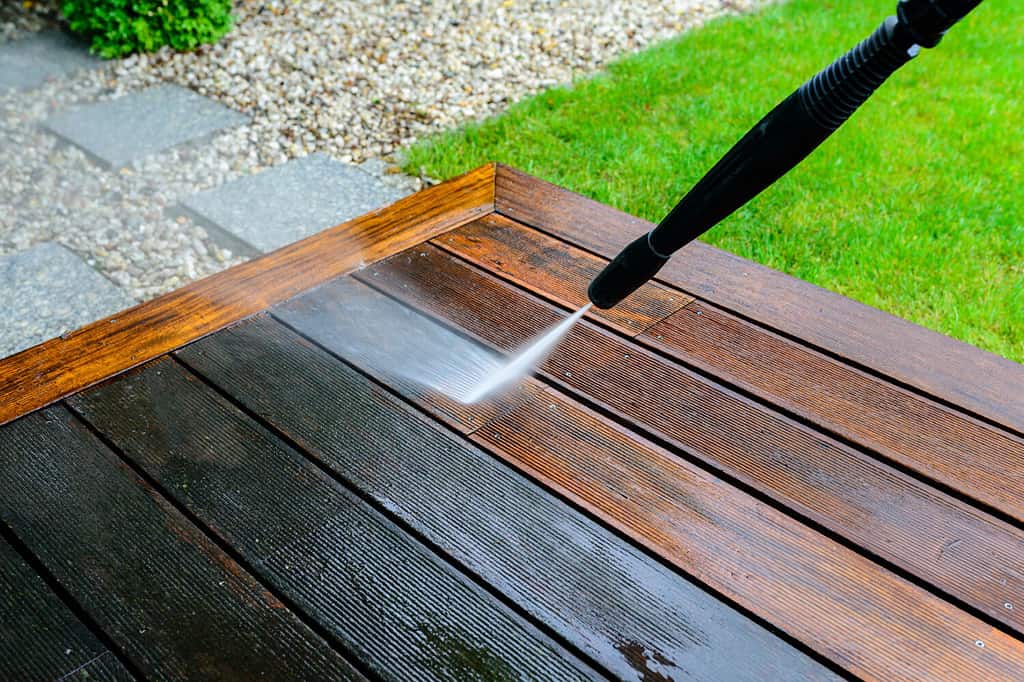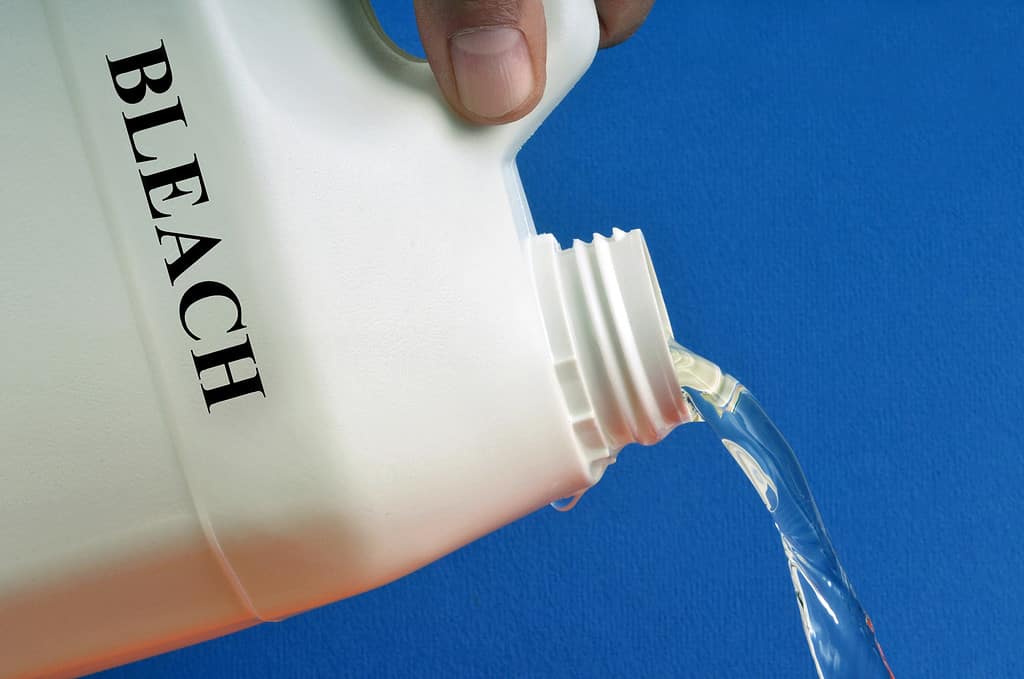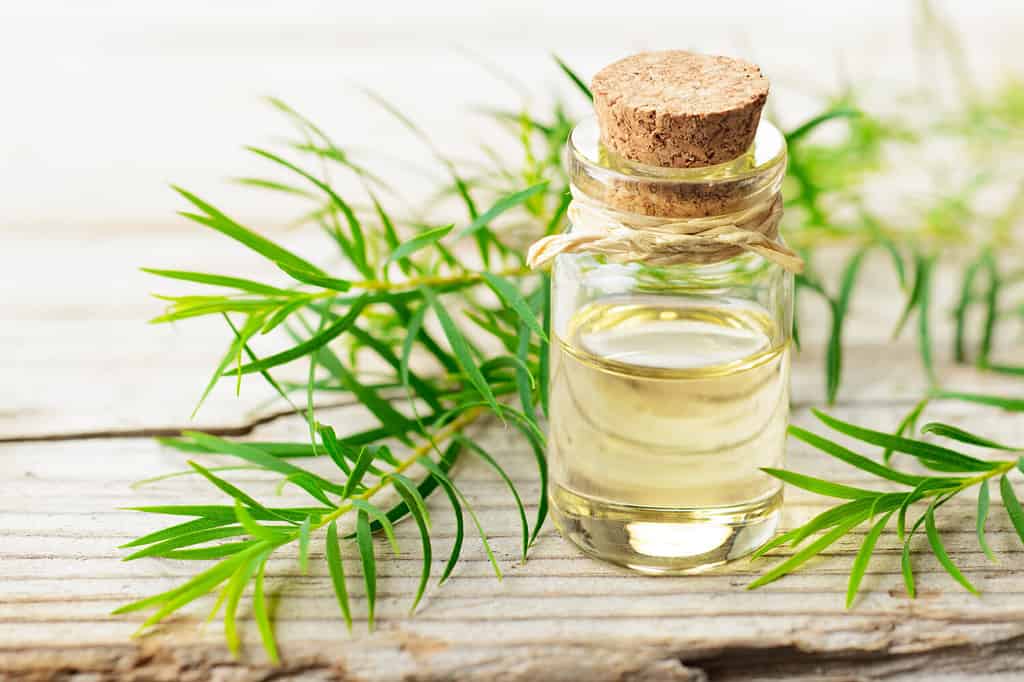Regular cleaning is essential for maintaining the beauty and longevity of your outdoor deck. Your deck accumulates dirt, grime, mold, and mildew, detracting from your home’s aesthetic appeal and potentially causing structural damage. While commercial deck cleaners are readily available, many homeowners prefer homemade solutions for a cost-effective and more environmentally friendly alternative.
Discover the most effective homemade deck cleaners, tailored to address different types of deck stains and dirt. Say goodbye to the hassle of expensive store-bought cleaners and explore the most efficient and eco-friendly ways to revitalize your deck’s appearance.
Vinegar and Water
Vinegar and water create a natural deck-cleaning powerhouse. It is one of the more eco-friendly and budget-conscious deck cleaning options available, and most homeowners have white vinegar in their kitchen pantry.
When combined with water, white vinegar creates a potent cleaner that can tackle deck stains and grime. Additionally, vinegar’s natural acidity makes it an effective solution for removing mildew and mold stains, which are common in damp or shaded areas. It also removes algae, green stains, and moss that develop in humid environments.
Furthermore, a vinegar solution breaks down and removes leftover marks from water stains and mineral deposits. Unfortunately, it is less effective than other cleaners at removing oil and grease stains.
Vinegar and water are suitable for most wood decking materials, including cedar, redwood, pine, and pressure-treated lumber. It is also safe for composite decking, PVC, concrete, brick, and stone surfaces.
Recipe:
- Mix equal parts white vinegar and water in a bucket.

Vinegar and water create a natural deck-cleaning powerhouse.
©bubutu/Shutterstock.com
Baking Soda and Water
The combination of baking soda and water is a powerful yet gentle option. The straightforward solution creates a spreadable paste that is particularly effective at addressing a range of stains and issues on various deck materials. It excels at tackling water stains left by rain or sprinklers, general grime and dirt accumulating on surfaces, food and beverage stains, and surface discoloration caused by various factors.
Moreover, the solution is generally safe for use on wood, composite, concrete, brick, stone, vinyl, and PVC decking materials. However, baking soda is ineffective in addressing mold or algae on decks. Still, its gentle yet effective cleaning action makes it a versatile and eco-friendly choice for most deck maintenance tasks.
Recipe:
- To create an effective cleaning paste, start with approximately one cup of baking soda and gradually add water until you achieve a thick, spreadable consistency.
Vinegar and Baking Soda
Vinegar and baking soda are well-known natural cleaning agents that, when combined, create a powerful solution. The vinegar’s acidity helps break down dirt, stains, and mildew, while baking soda’s mild abrasiveness aids in scrubbing away grime on your deck’s surface. This homemade deck cleaner is also eco-friendly and safe for most deck materials.
The combination approach works on dirt, grime, mold, mildew, algae, moss, water stains, mineral deposits, and most food stains. However, it is not effective at treating oil-based stains or rust. This dynamic duo is safe for cleaning wood, composite, concrete, and stone decks.
Recipe:
- Vinegar solution: Combine equal parts white vinegar and water in a bucket. This solution serves as your cleaning base.
- Baking soda paste: In a separate container, mix baking soda with a small amount of water until it forms a thick consistency.
Bleach Cleaner
Bleach cleaner effectively removes mold and mildew stains on decks but requires more precautions. Working with bleach requires protective gear, including gloves and eye protection. This homemade solution combines the power of bleach with mild liquid dish soap for effective stain removal.
Bleach deck cleaner is generally safe for use on various composite, vinyl, and concrete surfaces. However, it is not suitable for decks like wood with certain surface finishes or coatings, and it is essential to test a small, inconspicuous area of your deck before applying it broadly.
While bleach is effective for mold and mildew stains, it may not be the best choice for addressing other types of stains, such as oil or rust. Consider alternative cleaning solutions tailored to your specific stain for these types of stains.
Recipe:
- Mix one quart of water with one quart of household bleach in a bucket.
- Add 1/4 cup of mild liquid dish soap to the bleach and water mixture.

Bleach cleaner is not safe for use on wood decks.
©iStock.com/Richard Villalonundefined undefined
Borax and Dish Soap
Borax and dish soap combine to create a versatile and environmentally-conscious deck cleaner. Mild dish soap and borax, a naturally occurring mineral compound, remove dirt, stains, and grime from your deck. Borax also offers additional benefits, such as pest control and mold prevention, while dish soap enhances the solution’s cleaning performance.
The solution acts as a deterrent to unwanted pests like ants and termites while inhibiting mold and mildew growth. This eco-friendly deck cleaner is safe for most common decking materials, making it a practical choice for your deck maintenance. It works on dirt, grime, mold, mildew, algae, and moss. However, like most homemade deck cleaners, it is not effective on oil-based stains or rust.
Recipe:
- Mix one cup of borax with one gallon of warm water in a bucket.
- Add a small amount of mild liquid dish soap for enhanced cleaning power.
Dish Soap and Water
This uncomplicated homemade mixture combines the gentle cleaning power of mild liquid dish soap with the cleansing properties of warm water. When blended, they form a versatile cleaning solution that can tackle a variety of stains and dirt on your deck, including mildew, mold, moss, and algae. This solution is not only effective but also safe for most deck materials, making it an accessible choice for regular deck maintenance.
What makes this solution particularly appealing is its safety and versatility. It is suitable for various wood decking materials, including cedar, redwood, pine, and pressure-treated lumber, as well as some composite, vinyl, and concrete decks. It is also accessible and found in most households, making it a budget-friendly choice for routine outdoor cleaning.
Recipe:
- Mix one gallon of warm water with 1/4 cup of mild liquid dish soap in a bucket.
Tea Tree Oil and Water
Tea Tree Oil and water combine into a deck cleaner that brings the invigorating scent of nature to your deck maintenance routine. This homemade solution marries the gentle cleansing attributes of water with the mild yet effective disinfecting properties of tea tree oil. These ingredients lift away dirt and grime but also infuse your outdoor space with a fresh, natural aroma.
What sets this deck cleaner apart is its versatility. Tea tree oil and water work on dirt, mold, mildew, algae, and moss. Like other solutions, it is not effective for oil stains or rust. However, it offers additional advantages. Tea tree oil also deters pests from your outdoor space.
This eco-friendly and aromatherapeutic deck cleaner is particularly well-suited for wood decks, including cedar, redwood, pine, and pressure-treated lumber. However, it is less effective on other materials and may cause staining or slippery surfaces.
Recipe:
- Mix one gallon of water with 10 to 15 drops of tea tree oil in a bucket.

Tea tree oil is an excellent alternative to commercial pesticides.
©AmyLv/Shutterstock.com
Using Homemade Deck Cleaners
Regardless of the homemade deck cleaner you choose to tackle your outdoor project, the cleaning process follows a few simple steps and requires a few basic tools:
Tools:
- Broom
- Bucket
- Homemade deck cleaner
- Stiff brush or deck scrubber
- Mop (optional)
- Hose with a spray nozzle
- Protective gear: gloves and eye protection
- Tarp or plastic sheeting *optional
Steps to clean your deck:
- Prepare your deck: Collect your tools, materials, and protective gear. Clear your deck and sweep the surface to remove loose dirt and debris. Lastly, always test a small, hidden section of your deck to ensure that the homemade cleaner does not cause any adverse effects, such as discoloration or damage to your decking material.
- Protect your landscape: This step is optional but recommended. Use a tarp or plastic sheeting to cover sensitive landscape plants around your deck. The layer protects them from runoff, harsh sprays, and chemicals that might damage foliage, blooms, or root systems.
- Apply your homemade solution: Mix your homemade deck cleaner. Next, mop the solution onto your deck or use a scrub brush to apply it directly to problem areas or the entire surface.
- Wait and scrub: Let your homemade cleaner sit on your deck’s surface for 15 minutes to allow the cleaner to penetrate and loosen dirt, stains, and mildew. Use your brush, deck scrubber, or broom to scrub your deck’s surface vigorously.
- Rinse and dry: Use your hose with an attached spray nozzle to rinse your deck’s surface. After rinsing, let your deck air dry and avoid walking on your wet deck.
Homemade Deck Cleaners: Safety Tips
Homemade solutions are cost-effective, available, and typically environmentally friendly. However, like chemical cleaners, safety should always be your top priority. These simple yet crucial safety tips will help you enjoy a clean and secure deck cleaning experience:
- Protective gear: Before you begin, gather essential protective gear, including rubber gloves, safety goggles, and appropriate clothing. These items will shield you from potential skin irritation, chemical splashes, and eye injuries.
- Handling chemicals: When handling chemicals like bleach, follow the manufacturer’s instructions. Store chemicals in their original containers, and never mix different cleaning solutions unless directed. Lastly, always add chemicals to water, not the other way around, to prevent splashing.
- Safe application: Use appropriate tools like mops, brushes, or sprayers to minimize direct contact with the cleaning solution. Be cautious not to allow the solution to come into contact with your skin or eyes.
- Responsible water disposal: Avoid draining leftover cleaning solutions onto the ground or into storm drains.

Aim to re-stain your wood deck every two to three years.
©Pi-Lens/Shutterstock.com
Deck Maintenance
Regular deck maintenance not only enhances the aesthetics of your deck but also prolongs its lifespan. Depending on your deck’s age, location, and materials, the frequency of maintenance tasks may vary. However, there are some common elements to desk maintenance, including:
- Regular cleaning: Clean your deck annually to remove dirt, debris, and stains. Use cleaning solutions based on your deck’s material and the specific stains you want to tackle.
- Inspect for damage: Inspect your deck for signs of wear and damage, such as loose boards, nails, or screws. Address these issues promptly to prevent further deterioration.
- Sealing and staining: Apply a protective sealant or stain to your deck every few years, depending on the type of wood and your climate. This helps prevent moisture damage, fading, and UV radiation effects.
- Repair and replace: Replace any damaged or rotting boards. Tighten loose fasteners and address any structural issues to maintain your deck’s integrity.
- Clean your gutters: Ensure that your gutters and downspouts are clean and clog-free. Proper drainage prevents water from accumulating on your deck’s surface.
- Trim nearby vegetation: Trim overhanging branches and plants near your deck to prevent falling leaves, sap, or debris from accumulating and potentially staining or damaging your deck.
Bringing It All Together: Homemade Deck Cleaners and Routine Maintenance
Maintaining your deck is not only about preserving its visual appeal but also about ensuring your safety and your deck’s longevity. With routine cleaning, inspections, and timely repairs, you can enjoy an outdoor oasis that stands strong against the elements and provides a welcoming space for family and friends. No matter what decking materials you have, a little care and attention go a long way in keeping your deck in top condition. So, take the time to invest in the maintenance of your deck and enjoy a beautiful, functional, and safe outdoor living area for years to come.
Summary: 7 Effective Homemade Deck Cleaners
| Cleaning Solution | Deck Materials |
|---|---|
| White Vinegar & Water | Wood, composite, concrete, stone |
| Baking Soda & Water | Wood, composite, vinyl, concrete, stone |
| White Vinegar & Baking Soda | Wood, composite, concrete, stone |
| Household Bleach & Water | Composite, vinyl, concrete |
| Borax & Liquid Dish Soap | Wood, composite, concrete, stone |
| Liquid Dish Soap & Water | Wood, composite, vinyl, concrete, stone |
| Tea Tree Oil & Water | Wood |
The photo featured at the top of this post is © bubutu/Shutterstock.com
Thank you for reading! Have some feedback for us? Contact the AZ Animals editorial team.






